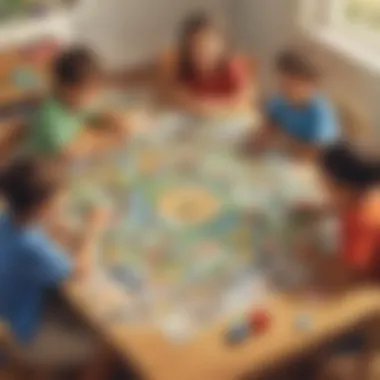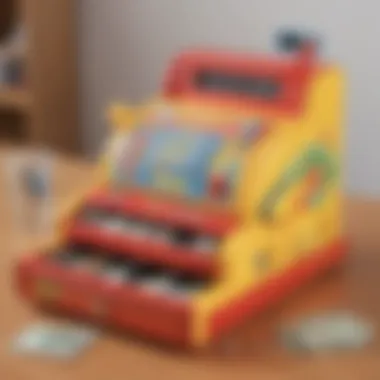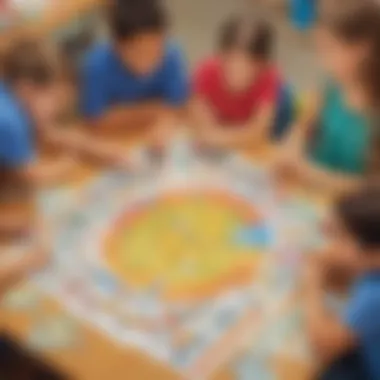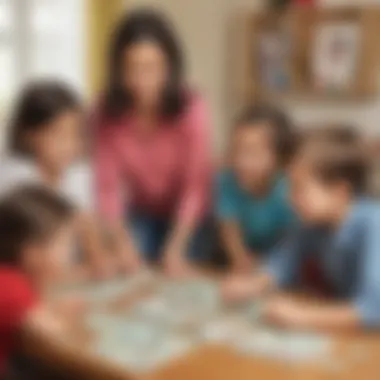Engaging Money Games for Second Graders' Learning


Intro
Understanding money is a vital skill for young learners. Financial literacy at an early age equips children with the tools they need to make informed decisions later in life. In this guide, we explore engaging activities designed for second graders that integrate fundamental concepts of money management with enjoyable gameplay. These activities can be executed both at home and in educational settings, making them versatile for a variety of learners.
The importance of combining math skills and real-world applications cannot be underestimated. By utilizing games and interactive play, children grasp the concepts effectively while having fun. Active learning transforms complex ideas into something tangible. Through hands-on experiences, children will be better prepared to understand prices, value, and basic budgeting.
Fun Activities Ideas
Engaging children through fun activities is essential for both engagement and learning retention. Below are a variety of activities that focus on money skills. Here we categorize them into indoor activities, outdoor adventures, and more.
Indoor Activities
Indoors, there are many games that instill the money-savvy mindset. Simple role-playing activities can involve kids pretending to manage a store. They can have make-believe transactions using play money. This helps familiarize them with basic pricing and the concept of exchange.
- Store Simulation: Set up a mini-store with various items. Use labels showing prices. Kids take turns being customers and store owners, practicing addition and subtraction.
- Board Games: Games like Monopoly Junior or Playing Cash are enjoyable and educational. They teach counting and decision-making.
Outdoor Adventures
Outdoor activities can enhance the learning experience too. Here, children can directly connect movement with financial concepts.
- Treasure Hunt: Organize a treasure hunt with clues related to counting or inching closer to monetary goals. Utilize small prizes at strategically placed locations.
- Market Visit: Take children to a local farmers market. Discuss how prices are set and ask them to calculate how much items would cost if they bought several.
Arts and Crafts
Artistic activities link creativity to learning well.
- Create a Savings Jar: Decorate containers, emphasizing the savings concept. Children can set saving goals and illustrate what their next purchase might be aiming for.
- Make Fake Money: Involve the children in crafting homemade currency. It serves as both a practical learning tool and a fun creative project.
Educational Games
Games that focus on mathematics and logic deepen the financial understanding of children. Structured lessons gained through play help solidify foundational concepts.
Math and Logic Games
Math games can range in complexity. Goalpea's Math Money Game combines money skills with mathematical operations, appealing to various learning styles.
- Pay Me in Change Game: Integrate counting strategies while sorting through different types of coins. Encourage teamwork by setting up challenges to collect exact amounts carefully. Enforce the value of dollars and cents simultaneously.
Language and Vocabulary Games
Associating language skills with financial literacy cannot be overlooked. Engaging with vocabulary helps children express monetary concepts articulately.
- Money Bingo: Adapt standard Bingo. Create cards featuring key finance terms. As you call out definitions or clues, kids mark terms. It's educational yet very exciting.
Interactive Learning Apps
Technology meets education through apps designed for teaching money management. These interactive experiences can cater to visual, auditory, and kinesthetic learners effectively.
- Apps like Fun Money or Savings Spree provide a dynamic way to explore finance concepts through play. Their engaging formats retain student attention.
Seasonal and Holiday Activities
Intriguingly, times during the year open up myriad activities that inherently teach financial skills. Seasonal events can be utilized as jump-off points for engaging learning.
Thanksgiving Cooking Projects
Include lessons about saving money while cooking. Budgeting for ingredients teaches practical skills. Tracking expenses for shopping also simulates real-world conditions.


- Create a Recipe Cost Chart: Involve children in planning meals and achieving target budgets simultaneuously. They can see where adjustments can be made.
Christmas Decorations
Creating decorative items can lead to discussions surrounding planned spending and thoughtful gifting.
- Gifting Budgeting Activity: Set a limit for purchasing or creating gifts while encouraging comparisons of costs along with creativity.
Parenting Tips and Resources
Guidance for parents can elevate the learning environment significantly. Balancing education with fun creates a solid foundation.
Motivating Kids to Stay Active
Encouraging outdoor activity develops health, while instilling principles of financial literacy simultaneously enriches formative skills.
In summary, integrating money-related games for second graders encourages creativity and sharpens mathematical abilities along with social skills. Engaging parents, guardians, and teachers plays a critical role in effective financial education which significantly enriches children’s lives.
"Comining gamification with learning cultivates a love for knowledge that lasts a lifetime."
Understanding Financial Literacy
Financial literacy plays a crucial role in developing essential skills in young learners. It goes beyond merely understanding how to handle money; it encompasses knowledge that enables second graders to make informed and effective decisions regarding their financial resources. At this early stage, children are particularly receptive to learning concepts that will form the foundation of their future money management.
Teaching financial literacy at a young age fosters critical thinking and encourages responsible behavior toward earning, spending, saving and investing. When engaged in money games, children experience realistic situations where they can practice these skills in an interactive environment. Understanding how money operates is not just about mathematics; it impacts various areas of life.
The Importance of Early Financial Education
Early exposure to financial education equips children with tools they will need in everyday life. It introduces basic principles like budgeting, saving, and the value of money. Research indicates that the formation of financial habits often begins in childhood. Therefore, financial literacy can decrease the chances of poor money management later in life.
- Enhancing Confidence: Gaining knowledge about finances boosts the self-assurance of children, preparing them to handle financial situations well into adulthood.
- Building Responsible Adults: When children grasp the significance of money, they are more likely to become thoughtful and responsible adults.
- Correcting Misconceptions: Teaching kids about money at a young age helps correct any misunderstandings they may have, such as equating financial success with materials alone.
Core Concepts in Money Management
It's essential to cover core concepts that build the base of financial literacy. These concepts help second graders understand the role money plays in their lives. Here are some foundational principles:
- Earning Money: Introduce the idea that money is earned through work, teaching them about various professions and how each contributes to overall society.
- Spending Wisely: Instruct them on making careful choices when it comes to spending. Discuss wants versus needs, showing them how to prioritize purchases.
- Saving and Investment: Explain what saving means and how it can lead to opportunities—discussing items they might want to save for, like toys or games.
Financial literacy can empower young individuals. Thus, incorporating money games from an early age not only supports academic skills but also shapes their future financial behaviors. A strong foundation created now will carry through their personal and professional lives.
"Teaching financial literacy is giving the children the ability to make informed choices."
Types of Money Games
Understanding how children learn about money through gameplay is crucial. Types of money games serve an essential role in developing a strong basis for economic comprehension. Through diverse formats, these games provide unique advantages that appeal to various learning styles. Additionally, they cultivate not only financial literacy but also critical thinking and social skills.
Games are enjoyable and engaging, encouraging participation from children. Implementing tactics that combine finance with fun creates a more effective educational experience. Right form board games to a digital gaming explore, uncovering possibilities in learning while playing maximizes children's understanding of key monetary concepts.
Board Games for Money Skills
Board games present an interactive method for teaching money skills. They offer opportunities for children to handle
Hands-on Learning Activities
Hands-on learning activities play an essential role in teaching money concepts to second graders. Children at this age benefit significantly from interactive experiences. These activities make abstract concepts, like currency and spending, more tangible and easier to understand. By combining education with fun, students are often more engaged and retain the knowledge they gain.
Practical experiences help to build a connection between classroom exercises and real life. These activities promote problem solving and critical thinking. Moreover, they encourage teamwork and communication, which are key skills in any social setting. Implementing hands-on learning can also allow teachers and parents to track the progress of each child in a more concrete way.


Setting Up a Classroom Store
Creating a classroom store provides a dynamic environment for learning about money management. This setup simulates real-world situations when students can role-play buying and selling items. Assigning prices to classroom supplies or snacks allows second graders to practice using physical money. For this activity, teachers can use play money to facilitate transactions.
To ensure effectiveness, it’s important to prepare beforehand. Choose a variety of items to sell that are both engaging and affordable. Involve students in deciding what items should be available, which promotes a sense of ownership. During the setup, explain how prices are determined and the concept of budgeting. Throughout the activity, encourage students to handle transactions, calculate change, and record purchases. They can easily grasp the consequences of overspending, rewarding both mistakes and successes in a low-stakes environment.
“Creating a classroom store allows children to experience financial transactions in real time and gain valuable lessons in decision-making.”
Money Bingo for Easy Recognition
Money Bingo is another engaging hands-on activity that helps reinforce the recognition of various coin values. In this game, students receive Bingo cards that display different coin denominations. The teacher randomly calls out a corresponding coin's name or value, allowing students to mark their cards.
This game introduces students to money names, values, and recognition. As they play, they learn to visualize currency in a fun and competitive setting. It’s also simple to modify this game for varying levels of complexity. For example, labels indicating the number of coins can be used for younger students, mixed-dimension games can assist advanced students, and adding math equations can benefit all.
To enhance the activity, do a recap after the game. Discuss which coins appeared most often, ask students about how much a specific coin is worth, or talk about a recent purchase they made using real money. By connecting the game to personal experiences, students can better consolidate their knowledge.
Incorporating Technology into Learning
In today's educational environment, integrating technology into learning promotes engagement and enhances the educational experience. For second graders, using technology can make complex concepts like financial literacy more tangible and relatable. Interactive tools captivate students' attention and motivate them to explore money management through various applications and resources.
Moreover, technology provides instant feedback, allowing children to identify their strengths and weaknesses promptly. This immediate response can help reinforce understanding while addressing individual learning paces. Such advantages create a supportive learning atmosphere that can make financial concepts less intimidating for young learners.
Apps for Teaching Money Skills
Apps specifically designed to teach money skills can be highly effective for second graders. These educational tools use gamification to make financial learning engaging. They offer various activities that help children understand topics such as counting money, making change, and recognizing the value of different denominations.
Several apps stand out in this educational journey:
- Pay Up: This app immerses students in a virtual business world where managing funds is key.
- Penny Pitch: With interactive challenges, children learn how to budget and save toward goals in a fun way.
- Savings Spree: A creative platform that teaches the basics of saving, spending, and sharing money wisely.
By utilizing these apps, educators and parents can encourage their kids to practice money skills in a controlled, playful environment.
Online Resources for Added Practice
Online resources can supplement in-class activities. Websites offering exercise videos, financial games, and tutorials can provide valuable insights. These platforms often have materials tailored for different age groups, making knowledge attration easier for second graders.
Some notable online resources include:
- Kahoot!: An interactive quiz tool that can be used to test financial knowledge swiftly.
- National Endowment for Financial Education (NEFE): Their website offers a range of downloads aimed at young students.
- PBS LearningMedia: Provides a variety of lessons and video segments regarding finances.
Integrating technology into learning is not just about enhancement; it’s about creating a comprehensive learning experience that resonates with the young mind’s curiosity and eagerness to learn.
Ensuring solid financial literacy foundations in children is critical. By adopting technologies suited for teaching money management, educators and parents can assist students in grasping these essential concepts effectively in today's digitally-driven world.
Craft Projects Related to Money
Craft projects related to money offer engaging ways for second graders to learn foundational financial concepts. Creating tangible objects related to money, such as piggy banks or worksheets, encourages both creativity and understanding in children. This hands-on approach reinforces the lessons they learn about financial literacy through play. These iterations of learning are essential for constructing a lasting grasp of essential money concepts.
Incorporating craft projects into financial education provides various benefits:
- Enhances Engagement: Kids naturally enjoy crafting. Integrating art with money skills promotes active participation.
- Promotes Critical Thinking: Designing items, like money worksheets, pushes children to apply what they know.
- Boosts Retention: Practical activities help solidify theoretical knowledge through muscle memory and visual learning.
As we look at two specific projects, creating a piggy bank and designing money worksheets, distinct methods to incorporate craft elements into the learning process become clear.
Creating a Piggy Bank
Building a piggy bank starts with easily accessible materials, making it an ideal project for classrooms or homes. The act of creation transforms saving into a tangible and enjoyable experience for children. They can decorate their piggy banks with personal flair, making the learning experience relatable and unique to each student.


Project Steps:
- Gather Supplies: This includes a plastic bottle, colorful paper, scissors, glue, and markers. These supplies can usually be found in most households or classrooms.
- Craft the Bank: Cut a slit in the top of the bottle to create a slot for inserting coins. Students can decorate the outside with stickers or drawings reflecting their personalities or hopes for what they will save for.
- Learning Activity: Teach kids about savings goals. Ask them what they wish to save for, opening dialogue about money management. This enhances understanding of the purpose of their piggy bank.
Real-Life Application of Money Concepts
Understanding the practical application of money concepts is crucial for second graders as it molds their financial literacy skills. At this stage, children begin to comprehend the relationship between monetary value and real-life situations. Engaging them in specific activities fosters a tangible understanding of how money operates in everyday circumstances. Two key aspects under this topic mainly include field trips to local businesses and budgeting for a classroom event.
Field Trips to Local Businesses
Field trips create an excellent opportunity for children to see money concepts in action. Visiting local businesses, such as grocery stores, bakeries, or markets, allows students to observe how transactions work. This exposure can lead to discussions as simple as how items are priced and how change is given when purchases are made. Understanding these basic transactions solidifies their comprehension of earning and spending money.
During the trip, guide students with questions, such as:
- How much does this item cost?
- How is the total amount calculated?
- If you had this much money, how many items could you buy?
These types of questions deepen their understanding and allow them to apply their knowledge practically. Additionally, students learn the value of making choices about spending, thus making their educational journey enjoyable and relevant.
Budgeting for a Classroom Event
Budgeting offers hands-on experiences that can greatly benefit children’s money management skills. Planning a classroom event requires making decisions based on available finances, which is a valuable lesson in prioritizing expenditures. Start by determining a budget with the students to cover expenses such as decorations, snacks, or supplies.
Steps to effectively teach budgeting include:
- Setting a Total Amount: Present a realistic budget for the event.
- Identifying Costs: Help students list potential expenses associated with the event.
- Allocating Funds: Teach them how to distribute the total amount to cover all necessary areas.
- Tracking Spending: Encourage them to keep account of money spent during the planning phase.
Through such activities, children learn essential budgeting skills and the importance of handling money responsibly. In doing so, they start developing a thoughtful approach to saving and spending, well-suited for their age and future financial decisions.
Key Insight: Practical experiences significantly enhance children's understanding of money management principles, leading to informed financial decisions as they grow.
Overall, the key elements of applying real-life money concepts build a foundational understanding for young learners. Practical experiences tie abstract concepts to reality, allowing children to grow with these skillsets.
Evaluating Progress in Learning
Evaluating progress in learning is a crucial aspect of teaching financial literacy to second graders. It allows educators and parents to determine how well children are grasping money management concepts. By assessing student progress, you can identify strengths and weaknesses in understanding, making it easier to tailor future activities. This form of evaluation helps to reinforce the skills needed for effective money management and also builds confidence in learners. Keeping track of how students engage with various games ensures that their comprehension is continuously developing.
Tracking Skill Development
Tracking skill development involves monitoring how students apply what they have learned through games and activities. Educators can use various methods to track this progress, such as:
- Observations: During games, listen and watch how students discuss concepts of money use or exchange. Note their interaction with peers and the skills they demonstrate.
- Checklists: Create checklists to assess which specific money skills students have achieved, like counting money accurately or understanding the concept of saving.
- Worksheets: After activities, having students complete related worksheets can show their understanding. This may include problems where they calculate total amounts or simulate spending.
Ulitmately, regular tracking helps educators ensure that financial concepts are not only taught but are also internalized by the students. It gives a better perspective of each child's learning journey and encourages positive educational improvements.
Assessing Understanding through Games
Assessing understanding through games can be an effective and intuitive way to measure students' grasp of money-related concepts. When children engage in game-based assessments, they often perform with more enthusiasm, which can lead to better insights into their comprehension levels. Games can be used in several ways for assessment:
- Game Performance: Observe how well children progress through financial games. Winning or completing levels usually reflects their understanding of money skills.
- Peer Interactions: Watch how students discuss strategies with peers during gameplay. Their willingness to share ideas may indicate their confidence and understanding.
- Reflection Sections: Incorporate short reflection periods post-gameplay. Asking students what they learned and what was challenging helps solidify their understanding.
Ending
Financial literacy is a set of skills that benefits children greatly. In the context of this article, it showcases how simple yet engaging money games enhance the learning experiences of second graders. These activities not only teach concepts of basic money management but also encourage students to apply their math skills in practical settings.
Parents and educators play a vital role in fostering such knowledge early. When children understand money concepts, they can confidently handle transactions and budgeting tasks as they grow. Research shows that children exposed to financial education are more likely to develop informed money habits later in life.
Engagement through play helps children absorb lessons more effectively. Using board games like Monopoly Jr. or digital games that simulate shopping experiences immerses kids in practical scenarios. Also, hands-on projects like creating piggy banks enable kids to physically interact with the concept of saving.
“Game-based learning in finance leads to longer retention of concepts among young learners.”
Key Takeaways for Parents and Educators
- Engagement is Key: Games create a playful environment that turns learning into an enjoyable experience, enhancing retention of concepts.
- Start Early: Introducing financial literacy as early as second grade helps shape money habits before they enter adolescence, a critical period for such knowledge.
- Variety in Learning: Utilize different formats, such as card games, digital platforms, and practical projects, to cater to varying interests and learning styles.
- Make It Collaborative: Parents engaging in money-related activities with their children develop both bonds and informative learning experiences.
- Progressive Learning: Emphasize practical application moving from games to real-world scenarios like shopping, budgeting, or managing allowances.
By understanding these key points, parents and educators can cultivate a robust foundation in financial literacy for children that lasts a lifetime.



